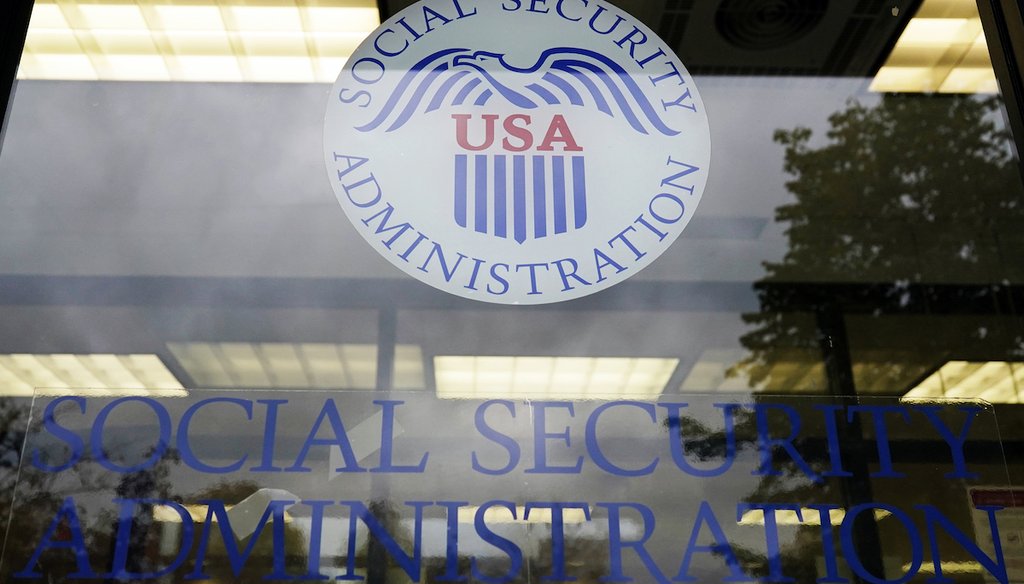Stand up for the facts!
Our only agenda is to publish the truth so you can be an informed participant in democracy.
We need your help.
I would like to contribute

The U.S. Social Security Administration office in Mount Prospect, Ill., Oct. 12, 2022. (AP)
If Your Time is short
-
If nothing changes, the Social Security trust funds will be depleted by 2034.
-
A Republican plan would keep the funds solvent by reducing future benefits, with no tax hikes.
-
Broadly, the GOP would shift money from those who earn more to those who earn less. But compared with current payment formulas, every group would get less.
Democrats look at the $1.27 trillion a year Social Security program and see their party’s legacy, a key piece of the country’s economic safety net.
Republicans see an entitlement program that more than 65 million people count on, but is fast becoming unaffordable.
In the final weeks before the 2022 midterm elections, Democrats are ringing the alarm that Republicans will gut the program.
"The Republican Study Committee, which represents a whopping 157 out of 211 House Republicans, holds slashing Medicare and Social Security as a core tenet of their proposed budget," House Speaker Nancy Pelosi, D-Calif., said Oct. 18.
The White House echoed that attack in a recent tweet.
"The vast majority of House Republicans have signed on to a Republican budget that will cut Social Security and Medicare," the Oct. 25 tweet said.
These barbs are not new. Democrats aim them at Republicans basically every election. House Republican Whip Steve Scalise of Louisiana called it "a typical red herring."
"We proposed strengthening, and shoring up Medicare and Social Security, which are both, by the way, headed for bankruptcy if we do nothing," Scalise said Oct. 16 on "Fox News Sunday."
Scalise is right about Social Security’s financial status if nothing changes.
There’s about $2.9 trillion in the program’s combined trust funds. Without some intervention, those reserves will run out by about 2034. The program will continue to pay benefits, but without additional dollars, it could afford to pay only between 70% and 80% of the benefits people expected.
There are a number of Democratic proposals to shore up Social Security. President Joe Biden floated a plan during the 2020 election that lifted a million seniors out of poverty, funded by a tax hike on households making over $400,000 a year. The Democratic options vary, but all have been more generous than what the GOP has offered. The question now is, what do the Republicans have in mind?
In February, Sen. Rick Scott, R-Fla., unveiled a broad policy agenda that included a bullet point that said, "All federal legislation sunsets in five years. If a law is worth keeping, Congress can pass it again."
Democrats treated this to say that Social Security would be at risk every five years. But that overlooked another point in Scott’s plan that assumed the program would continue.
In any event, few Republicans embraced Scott’s agenda. Senate Minority Leader Mitch McConnell, R-Ky., distanced Republican leadership from the plan.
In June, the House Republican Study Committee produced its own Social Security reform plan. It largely made no changes for current or near-retirees. But people retiring after 2030 would see a change in their monthly checks. The plan would offer a more generous minimum benefit than current rules do. It would do the most for people who have worked 40 years and were making about $47,000 or less at retirement.
Overall, lower-income workers would see their benefits rise faster than higher-income recipients.
The plan also would raise the age at which people could claim their maximum payment from 67 today to 70 in 2040. People who opted to start receiving benefits before that age could continue to work and not face a temporary reduction in their monthly checks as they do now.
The architects of the plan included no tax increases and called for Congress to allow workers and employers to put money into private retirement funds rather than the Social Security trust funds.
The Republican Study Committee plan has not been endorsed as party doctrine. You won’t find it, for example, in the House Republicans’ Commitment to America, a broad set of principles and policy goals.
The backbone of the Republican Study Committee’s work is the 2016 Social Security reform bill by the late Rep. Sam Johnson, R-Texas. The committee made a few changes, but pulled over much of Johnson’s work intact.
Separate assessments by Social Security’s actuaries and researchers at the Urban Institute, a Washington, D.C.-based policy organization, found that the Johnson plan would shrink Social Security by reducing the rate of growth of benefits. The study committee’s version would do the same, though the Urban Institute told us the reductions would be a bit deeper than in the Johnson plan.
By 2060, total benefits under the Johnson plan would be about 25% less compared with how the program runs today — adjusted for inflation, the number of recipients and other cost drivers.
Under that plan, every group gets less. From the bottom fifth of earners who would get 12% less all the way to the top fifth of earners who would get 44% less.
But total spending is only part of the picture. It’s important to look at how the plan divides whatever money it has among different income groups.
The Urban Institute analysis found the Johnson plan shifted payments from people with high incomes and lifetime earnings to those with lower incomes and lifetime earnings. The institute measured this against how much Social Security would be legally able to pay if lawmakers didn’t act (known as current law payable). And they looked at where things would stand in 2065.
Given the way income, education and ethnicity line overlap in the U.S., the country’s two largest nonwhite groups would also do relatively better.
"These changes would increase payments to Black and Hispanic beneficiaries and beneficiaries with limited education and would reduce payments to white beneficiaries and college graduates," the Urban Institute analysts wrote.
The head of the Republican Study Committee Rep. Jim Banks, R-Ind., highlighted one clear achievement with the plan.
"This budget would ensure the survival of the Social Security program and protect the low- and middle-income retirees who rely on it," Banks said June 9.
Independent analysts agree that overall steep reduction in spending would keep Social Security’s trust funds solvent. Who it protects is subject to debate.
Sita Slavov, a policy researcher at George Mason University, focuses on how Social Security shapes people’s decision to work. In that respect, she said the Johnson plan cuts both ways. For seniors who want to keep working, a couple of features would let them do that without seeing a change in their benefits.
"That would improve work incentives for older people," Slavov said.
On the other hand, she said a provision that eliminates cost-of-living adjustments for higher-income recipients could have the opposite effect.
Slavov also noted that the study committee's plan to raise the retirement age amounts to a benefit cut.
That change triggers a particular concern for Alicia Munnell, director of the Center for Retirement Research at Boston College.
"Raising the retirement age is the worst way to cut benefits," Munnell said. "It hurts most the people who can’t work any longer. These are people with less education and physically harder jobs. They get stuck with lower benefits for the rest of their lives."
A study from Munnell’s center found that among Black men with less education, about half who are working at age 62, are unable to continue to work until the current full retirement age of 67. For less-educated white men, about a quarter are unable to keep working long enough to take advantage of the full benefit.
Munnell said that retiring at 62 rather than 67 translates into a 30% reduction in someone’s monthly check. If the retirement age rises to 70, benefits drop by 45%.
A person’s capacity to work longer has implications for a key feature of the Republican Study Committee approach — a more generous minimum benefit for people who have the lowest earnings. But to fully qualify, a person must work 40 years.
"It is unusual to find people towards the bottom end of the income distribution that actually have all 40 years of covered employment, which you need to access the higher benefit," said Pamela Herd, professor of public policy at Georgetown University.
Herd raises another issue with the committee’s benefit formula: It uses a lower percentage on income above $60,000 than is in place now. The lower percentage leads to a lower monthly check.
"In practice, you're hitting people with benefit cuts at and above roughly 55% of median wages," Herd said. "It's definitely not just hitting people with the highest incomes."
Bipartisan Policy Center senior vice president William Hoagland said shoring up Social Security requires two balancing acts.
"How to ensure those at the lower end of the Social Security benefit schedule continue to receive, and in fact increase their benefits, while adjusting the formula at the higher end to provide smaller benefits," Hoagland said. "And how to make a balance between reduced benefits and increased revenues from the payroll tax."
The center’s plan used roughly a 50-50 split.
RELATED: Social Security: A critical program with an uncertain future
Our Sources
House Republican Study Committee, FY 2023 budget, June 9, 2022
Social Security Administration, Estimated effects of Social Security Reform Act of 2016, Dec. 8, 2016
U.S. Social Security Administration, Proposals to change Social Security, 2022
Urban Institute, Comparing Democratic and Republican Approaches to Fixing Social Security, Dec. 2, 2020
Center for Retirement Research at Boston College, Are Older Workers Capable of Working Longer?, July 2021
Bipartisan Policy Center, Securing Our Financial Future, June 9, 2016
Congressional Research Service, Social Security Primer, July 6, 2022
Brookings Institution, Social Security is drying up. This plan could save it, May 3, 2019
Rick Scott, Rescue America: Government reform and debt, February 2022
U.S. Congress, Social Security Reform Act of 2016, Dec. 8, 2016
U.S. Bureau of Labor Statistics, Median earnings for women in 2021 were 83.1 percent of the median for men, Jan. 24, 2022
Urban Institute, Five Democratic Approaches to Social Security Reform, October 2020
House Speaker Nancy Pelosi, Leader McCarthy’s Threat: Slash Medicare & Social Security or Tank the Economy, Oct. 18, 2022
White House, tweet, Oct. 25, 2022
Fox News Sunday, Interview with Steve Scalise, Oct. 16, 2022
Social Security Administration, Cumulative combined OASI and DI fund balances, 2022
Democratic National Committee, Republicans Will DO ANYTHING to Cut Social Security and Medicare, Oc.t 18, 2022
Urban Institute, How Would Joe Biden Reform Social Security and Supplemental Security Income?, Oct. 8, 2020
Email exchange, press office, Republican Study Committee, Oct. 24, 2022
Email exchange, Richard Johnson, director, Program on Retirement Policy, Urban Institute, Oct. 25, 2022
Email exchange, Pamela Herd, professor, McCourt School of Public Policy, Georgetown University, Oct. 25, 2022
Email exchange, Sita N. Slavov, professor of policy and government, George Mason University, Oct. 25, 2022
Interview, Alicia Munnell, director, Center for Retirement Research, Boston College, Oct. 25, 2022




















































